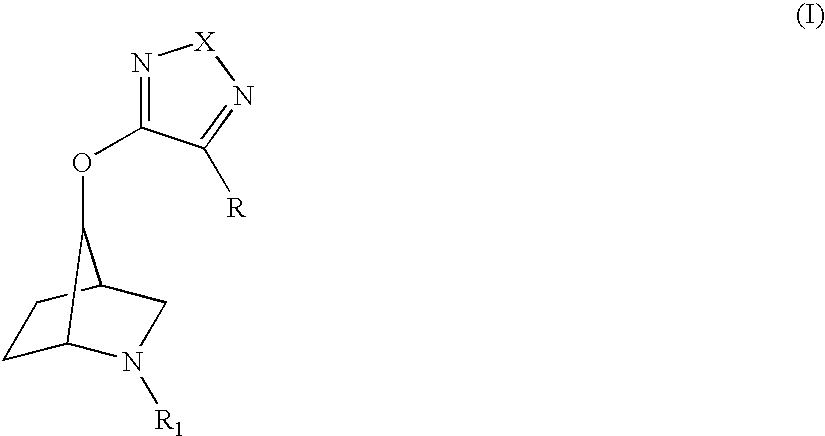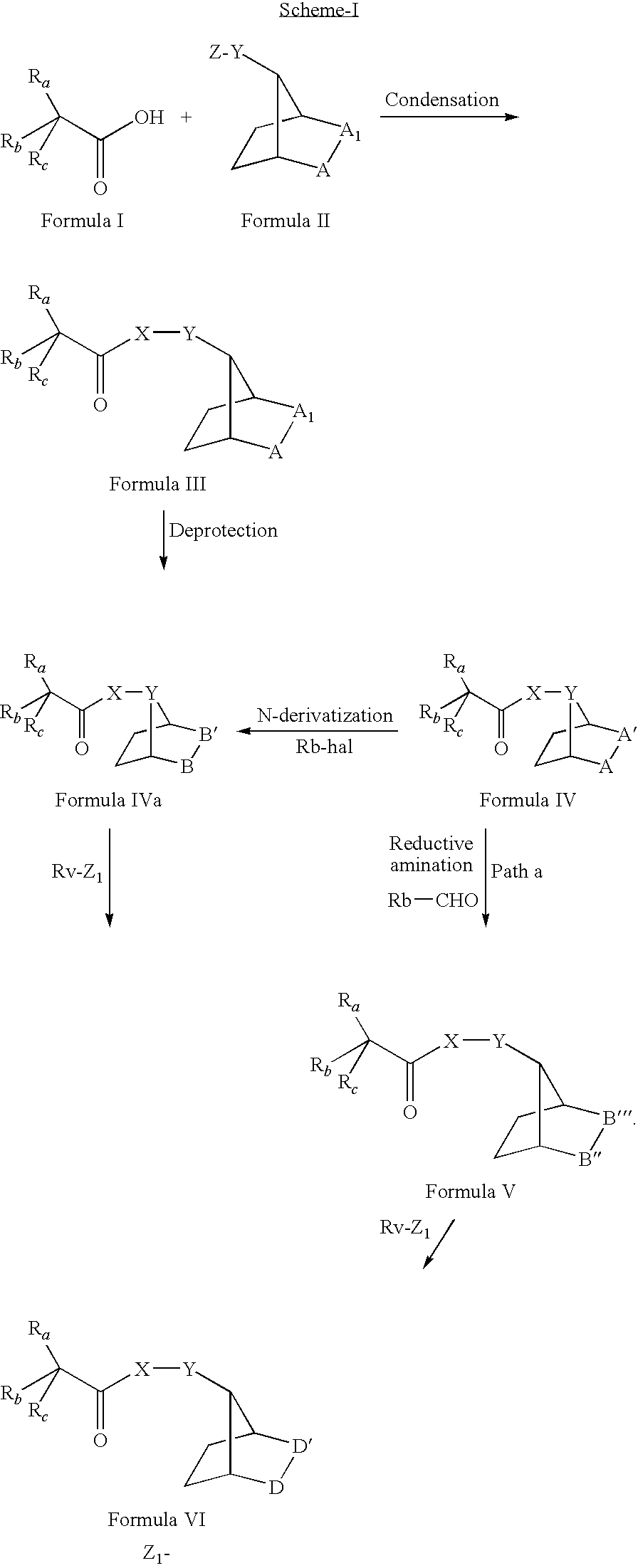Muscarinic receptor antagonists
a technology of muscarinic receptor and antagonist, which is applied in the field of muscarinic receptor antagonists, can solve the problems of limited therapeutic utility and poor tolerability of antimuscarinic drugs, and achieve the effects of high affinity for them and significant potency in terms of their activity
- Summary
- Abstract
- Description
- Claims
- Application Information
AI Technical Summary
Benefits of technology
Problems solved by technology
Method used
Image
Examples
example 1
Synthesis of 2-benzyl-2-azabicyclo[2.2.1]hept-7-yl 2,2-diphenylpropanoate (Compound No. 11)
[0195]To the solution of 2,2-diphenylpropanoic acid (1.69 mmol) and 2-benzyl-7-bromo-2-azabicyclo[2.2.1]heptane (1.12 mmol) in dry toluene, was added 1,8-diazabicyclo[5.4.0]undec-7-ene (2.25 mmol) and refluxed overnight. The reaction mixture was then concentrated under vacuum. The residue thus obtained was purified by column chromatography using 8% ethyl acetate in hexane as eluent to furnish the title compound.
[0196]Yield: 230 mg.
[0197]1H NMR (CDCl3): δ 7.31-7.19 (15H, m), 5.08 (1H, s), 3.66 (2H, s), 3.13 (1H, s), 2.96-2.93 (1H, m), 2.30-2.25 (2H, m), 1.89 (3H, s), 1.32-1.23 (4H, m).
[0198]Mass (m / z): 412 (M++1).
Analogues of 2-benzyl-2-azabicyclo[2.2.1]hept-7-yl 2,2-diphenylpropanoate (Compound No. 11 described below, were prepared similarly, by coupling racemic or optically active acid with racemic or optically active amine:[0199]2-Benzyl-2-azabicyclo[2.2.1]hept-7-yl hydroxy(diphenyl)acetate ...
example 2
Synthesis N-(2-benzyl-2-azabicyclo[2.2.1]hept-7-yl)-2,2-diphenylpropanamide (Compound No. 7)
[0225]To the solution of 2,2-diphenylpropanoic acid (1.32 mmol) and 3-azabicyclo[3.2.1]octan-8-amine (1.46 mmol) in dimethylformamide cooled in ice bath, was added N-methyl morpholine (2.63 mmol) and 1-hydroxybenzotriazole (1.46 mmol). The reaction mixture was stirred at the 0° C. for one hour followed by the addition of 1-(3-dimethylaminopropyl)-3-ethylcarbodiimide hydrochloride (1.32 mmol) and the resulting reaction mixture was stirred at same temperature for one hour and then left at room temperature for overnight. The reaction mixture was quenched by addition of water and extracted with ethylacetate. The organic layer was separated, washed with water and brine, dried over sodium sulphate and concentrated under reduced pressure. The compound was then purified by column chromatography using 25% ethylacetate in hexane as eluent to furnish the title compound. Yield: 180 mg.
[0226]1H NMR (CDCl3...
example 3
Synthesis of N-2-azabicyclo[2.2.1]hept-7-yl-2,2-diphenylpropanamide (Compound No. 15)
[0233]To the solution of the Compound No. 7 (125 mg. 0.30 mmol) in methanol, was added palladium on carbon (10% w / w) and ammonium formate (1.76 mmol). The reaction mixture was refluxed for 3 hours. The mixture was filtered through celite pad and washed with methanol. The filtrate was concentrated under vacuum. The crude compound was diluted with water and acidified using concentrated hydrochloric acid. Impurities were extracted with dichloromethane. The aqueous layer was basified and extracted with ethyl acetate. The organic layer was separated, washed with water and brine, dried over anhydrous sodium sulphate and concentrated under reduced pressure to furnish the title compound.
[0234]1H NMR (CDCl3): δ 7.36-7.20 (10H, m), 5.35-5.30 (1H, m), 4.10-4.09 (1H, m), 3.62-2.37 (5H, m), 2.01-1.98 (3H, s), 1.29-0.86 (4H, m).
Analogues of N-2-azabicyclo[2.2.1]hept-7-yl-2,2-diphenylpropanamide (Compound No. 15) ...
PUM
| Property | Measurement | Unit |
|---|---|---|
| Electrical conductance | aaaaa | aaaaa |
| Electrical conductance | aaaaa | aaaaa |
Abstract
Description
Claims
Application Information
 Login to View More
Login to View More - R&D
- Intellectual Property
- Life Sciences
- Materials
- Tech Scout
- Unparalleled Data Quality
- Higher Quality Content
- 60% Fewer Hallucinations
Browse by: Latest US Patents, China's latest patents, Technical Efficacy Thesaurus, Application Domain, Technology Topic, Popular Technical Reports.
© 2025 PatSnap. All rights reserved.Legal|Privacy policy|Modern Slavery Act Transparency Statement|Sitemap|About US| Contact US: help@patsnap.com



